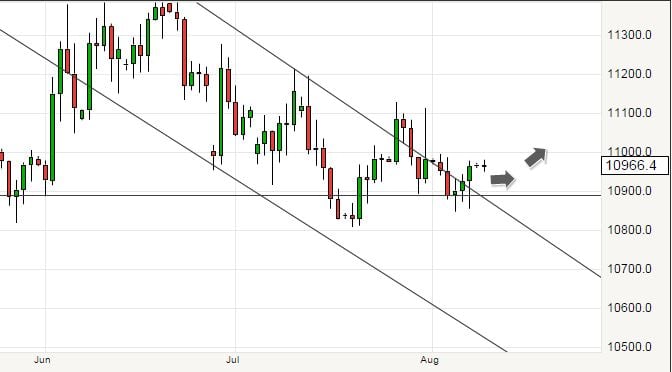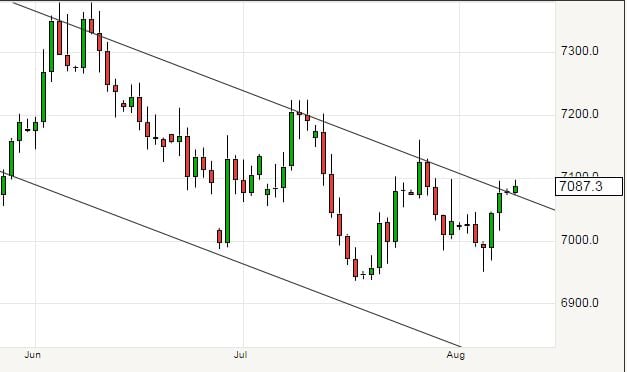EUR/USD: 1.09 Critical to the Outlook
- Written by: Gary Howes
-
Can the euro exchange rate complex (EUR) over come key sticking points to extend short-term advantage?

The euro notched new August highs against its U.S. counterpart as China’s move to cheapen its currency fanned worries about global growth, triggering an unwinding of carry trades funded with the low-yielding single currency.
"The euro’s resilience of late doesn’t appear convincing beyond the short run after German investor optimism unexpectedly darkened in August, sliding for a fifth month in a row," warns Joe Manimbo, an analyst with Western Union.
Concerning the outlook, a break above 1.10 opens up the prospect for a rally towards 1.12. We don’t fancy any moves beyond this point. Indeed, the longer-term prospects facing the currency are negative owing to the overwhelming influence of interest rate divergence.
With the US and UK looking to raise rates and the Eurozone facing at least another year and a half of record low rates the outlook for the shared currency remains negative.
Any rallies will be viewed as entry levels for selling EUR/GBP and EUR/USD by speculative traders.
Be aware: The quotes given in this article refer to the interbank market, from where your bank will affix a spread when conducting international payments. However, an independent FX provider will seek to get you closer to the market, resulting in the delivery of up to 5% more FX than your bank would have provided. Learn more here.
Euro / Dollar Fails to Beat 1.10 Level
Technical analyst Karen Jones with Commerzbank tells us that EUR/USD seems to be side-lined around the 1.1000 area but may still slip towards the May and July lows at 1.0819/08 in the course of this week.
“Failure there is needed to trigger losses towards 1.0524/1.0457, the base of the 30 year channel and March low. Minor resistance is found 1.1000 ahead of 1.1129, the late July high. While it caps, we will retain a negative bias. Above it lies the 1.1216 July high. Medium term we continue to look for EUR/USD to remain capped by the May and June highs at 1.1440/68,” says Jones.
We note how 1.09 is proving to be an increasingly important zone of support to the EUR/USD, as shown in the below graphic.
The support zone is becoming as much of a feature for the pair as is the descending channel, the validity of which is now being questioned.
In our opinion a break back into this channel is needed to confirm our near-term negative bias.
"We have seen EUR USD rebound from testing 1.0850 support early last week. This comes as EUR net shorts in the week ending August 8 extended to two-month highs. The extension in speculative holdings contrasts with long-end spreads, which have retreated substantially from levels seen at the end of last month," says Jeremy Stretch, currency analyst with CIBC in Canada.
Stretch reckons if we see 10-year spreads testing towards early July lows, just above 150bp, expect EUR USD to remain well supported, although for now it seems tough to suggest we can breach near-term resistance at 1.0996. Unless we close above the 1.1010/20 region we would retain a bias towards fading any EUR rallies.
SEB Bank say:
"The pair moved a tad higher (1.1042) than expected before turning around and falling back lower. A close at current levels (or lower) will create yet another 55d ma band rejection indicating that the sellers still are in control. A sustained break below 1.0926 will sharply up a bearish outlook calling for a swift continuation down to the recent low area."
Euro / Pound: Negative Bias Ending?
EUR/GBP once again stabilised above the 0.6937 July low by bouncing off last week’s low at 0.6952.
“The .6952/37 area will act as the break down point to the .6541 2007 low. A longer term negative bias is entrenched below the 2015 downtrend. It is currently located at .7172,” says Jones.
Commerzbank say that in the short term the three month resistance line at 0.7097 should be retested this week but may cap with the 55 day moving average at 0.7125.
With no major euro data out today, markets will focus on the day’s Fed speeches.
Last week, FOMC Member Lockhart made hawkish comments in an interview with the WSJ, and markets will watch to see whether he makes further hawkish comments today. If he does, we may see the dollar strengthen.
FOMC Member Fischer will speak first (12:15pm).
The week ahead is expected to see the German ZEW sentiment continue to modestly recover from Greek related uncertainties, while the provisional estimate of Q2 eurozone GDP is expected to reveal a ninth straight quarter of expansion. Expect some residual EUR support as Greece seems to be moving towards a third bailout deal, ahead of the August 20 ECB bond repayment.
We remain mindful of the fact that the passage through the Greek Parliament in the next few sessions, ahead of a ratification by the eurogroup, will likely predicate early elections, most likely in the middle of next month.
Chinese Yuan Devaluation Hits Asia
The PBoC decision to lower the value of its currency affected most Asian regional currency exchange rates with the Australian dollar, New Zealand dollar, South Korean won and Taiwanese dollar down more than 1% versus the US dollar.
The highly China sensitive Aussie dropped as much as 1.80% versus the greenback, as NAB Business condition fell to 6 from 10 a month earlier, while the NZD/USD fell 1.30%.
On the equity front, Asian equity markets are mostly trading into negative territory with the Japanese Nikkei down -0.42%, S&P/ASX down -0.65%, New Zealand shares -0.73% and South Korean’s Kospi -0.82%. On the other hand, Shanghai Composite is up 0.64%, Shenzhen Composite gains 1.38% while Hong Kong’s Hang Seng adds 0.75%.
.












